Vision of a Prosperous Energy Future for Finland
The Finnish economy has been stagnant for some time, and this has caused a funding crisis for the welfare state. The energy sector offers solutions to Finland’s problems. We do this by investing in the future and inviting everyone to join in making a change. Our vision for Finland's energy future presents two alternative scenarios: in the best case, we are European champions of the energy transition; in a less ambitious scenario, we are persistent performers.
Persistent performer or European champion of the energy transition?
Finland has a good chance of being a European champion of the energy transition by 2040. Finnish society, energy users and the environment will greatly benefit from this. There will be enough energy to meet the needs of an electrified society and industry while also taking care of our natural capital. An advanced and clean energy system will be based on flexible cooperation between production and consumption through strong networks.
In 2040, the challenges of the 2020s have been tackled with significant investments in energy production and networks, creating favourable conditions for a new era of industry and services. A new chapter has been written in Finland’s success story, securing the funding of the welfare state.
Even in a less bold vision of the future, Finland has made a demanding and persistent performance. We have fulfilled our obligations, but we end up reading about the success stories of others.
Download the vision as pdf
6.9 bn €
Annual energy investment if we achieve the European championship of the energy transition in 2040.
2.7 bn €
Annual energy investments in the Persistent Performer scenario in 2040.
Clean energy as an enabler of green growth
By 2040, Finland’s economy will be driven by industries and services based on clean electricity, hydrogen, and captured carbon dioxide. Their development is based on reliable and competitive energy.
Hydrogen produced with clean electricity will be used to clean up industry and as a raw material for synthetic fuels. The data economy with its data centres uses a lot of clean electricity. The electrified economy will be in full swing, and the heat generated as a by-product of industry and services keeps our homes warm without emissions.
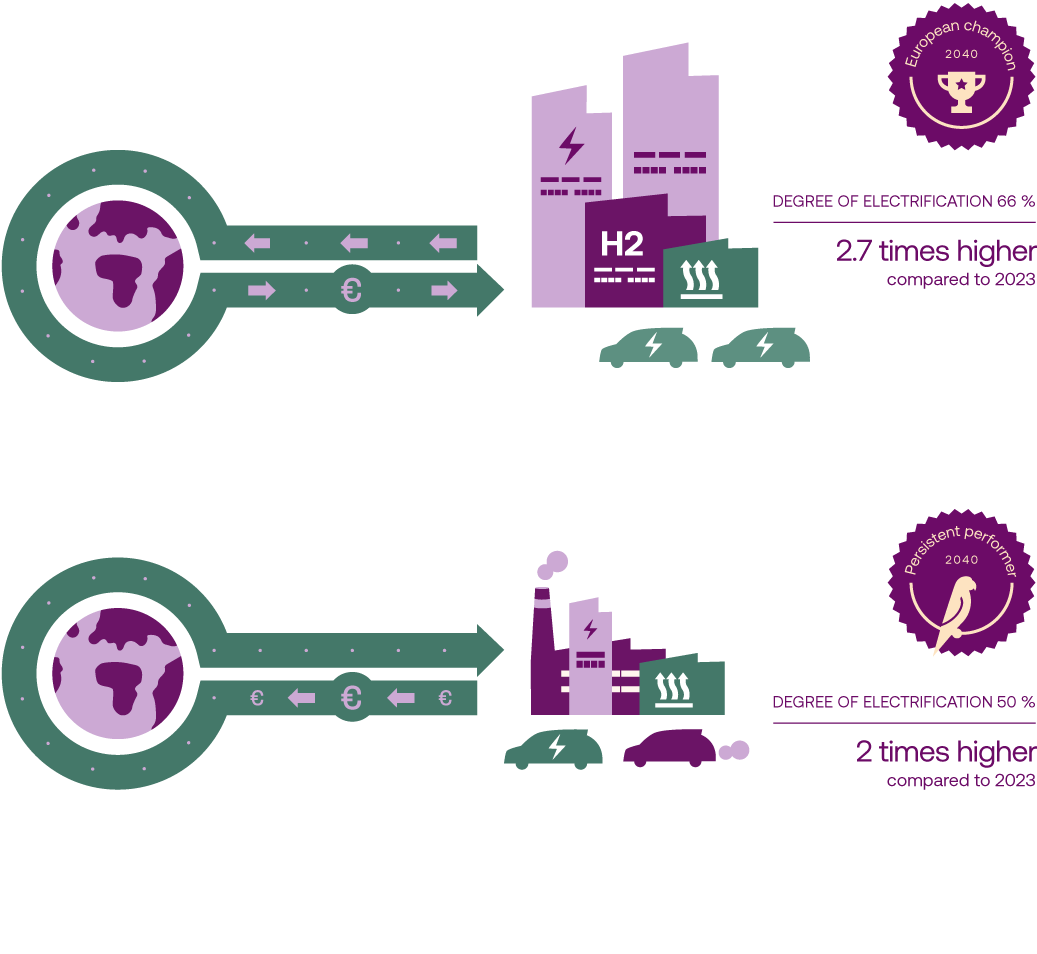
Finland is the best country in Europe for energy-intensive industries and produces high-value-added products for the European and global markets.
Hydrogen produced with clean electricity is used in the export industry, which has grown in Finland. The main use of hydrogen is as a raw material in the chemical and metal industries. Hydrogen is also used to produce clean fuels for transportation and industrial needs.
Finland has managed to retain part of its energy-intensive industry by electrifying its processes and improving energy efficiency. Fossil hydrogen has been replaced with hydrogen produced using clean electricity in its traditional applications, such as the production of liquid fuels and nitrogen fertilisers.
Products of the new, clean economy are imported from Sweden, Central Europe, the United States, and China. The energy sector can directly and indirectly employ 60,000 people.
Finland is heated not only with heat pumps and electricity with variable pricing but also with wood fuels. Over one million electric cars cover more than 50 percent of the driven kilometers. Some households mitigate energy costs by actively managing their energy use. Households have adapted their energy consumption to rising and fluctuating fuel prices.
40 bn €
Potential contribution of the energy economy to the national economy in the European Champion scenario.
10 bn €
Potential contribution of the energy economy to the national economy in the Persistent Performer scenario.
The energy future needs its makers
What makes up the European championship team of the energy transition? At least installers, product developers, digital experts, technical salespeople, customer service representatives, nuclear physicists, and interdisciplinary specialists.
They continuously develop and implement solutions that benefit society, energy users, and the environment. Particularly valuable skills for building a bright energy future include:
- Learning skills, interaction and problem solving
- Science and mathematics
- Digitalisation and data analytics
- Cybersecurity
- Customer service and sales
- Project management
- Environmental responsibility and sustainable development
If we achieve European leadership in the energy transition by 2040, the energy sector will directly and indirectly employ 100,000 people. If we remain resilient performers, that number will be 60,000.
Hydrogen economy requires more electricity
Hydrogen is used to produce fuels for applications where switching directly to electricity is not viable. Climate-neutral fuels are obtained by combining hydrogen with captured biogenic carbon.
The flexibility of hydrogen production and storage smooths out electricity price fluctuations. Hydrogen is also used in international energy trade.
In the scenario of a persistent performer, the conditions for strong growth in the hydrogen economy have not been realised in Europe, and the majority of Europe’s hydrogen needs are met through imports. Even here, hydrogen produced with clean electricity replaces some of the industry’s hydrogen demand, and new production of synthetic fuels has emerged to a limited extent.
Emissions fall below zero
In 2024, emissions from electricity and district heating have decreased by 59 percent from 2015 levels. The phase-out of fossil fuels continues at a rapid pace in both district heating and electricity production, leading to a significant reduction in emissions even before 2030.
Carbon sequestration in waste incineration and biomass power plants will enable the energy sector to reduce its net emissions to zero or even negative by 2035.
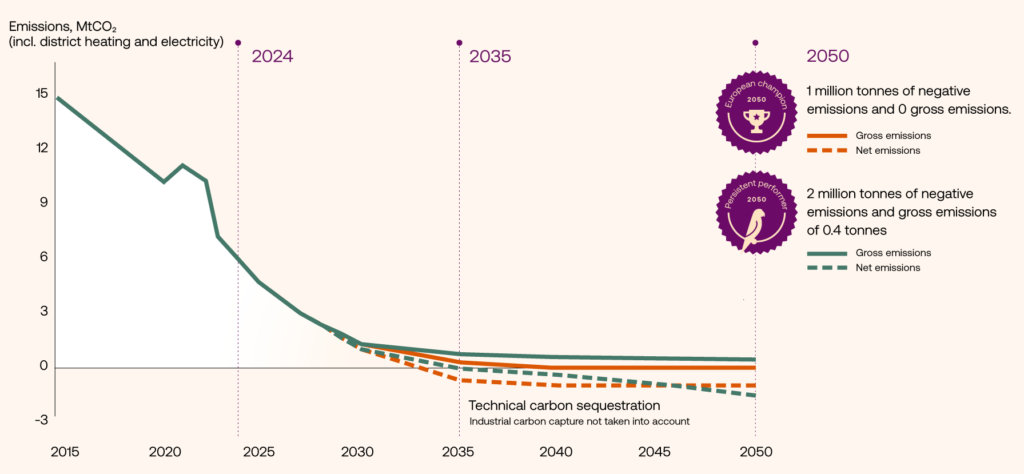
Storing carbon or recycling it into new products
Carbon capture offers an additional means of achieving carbon neutrality and removing carbon dioxide from the atmosphere.
Currently, 28 Mt of biogenic carbon dioxide is generated in Finland, particularly in the forest industry, as well as in waste incineration and other energy production. This carbon dioxide can be captured and either permanently stored or used in various products as a substitute for fossil raw materials.
At present, storage is not economically viable. According to a study commissioned by the Finnish Climate Change Panel, the estimated total costs for capturing and storing a ton of carbon dioxide from industrial emission sources in Finland around 2030 range from approximately 120 to 240 euros, depending on the capture site.
In Finland, plans emphasise the utilisation of captured carbon dioxide in the production of synthetic methane and methanol, which can be used as fuels and as raw materials for chemicals.
There are no geological formations suitable for permanent storage in Finland. Storage requires transport, for example to storage sites in the North Sea.
In Finland, several projects are underway to produce new products, such as fuels and chemicals, from captured carbon dioxide and hydrogen.
Unprecedented growth of clean electricity
In the European Champion scenario, onshore wind power production has increased eightfold. The champion also requires a substantial amount of offshore wind power, solar power, and small nuclear power. Maintained and developed hydropower, traditional nuclear power, and sustainable fuels balance the production. If we can’t achieve this, then who can?
Even in the Persistent Performer scenario, Finland meets its climate and energy obligations, but economic growth remains modest. Additional clean electricity is obtained through significant investments in wind and solar power.
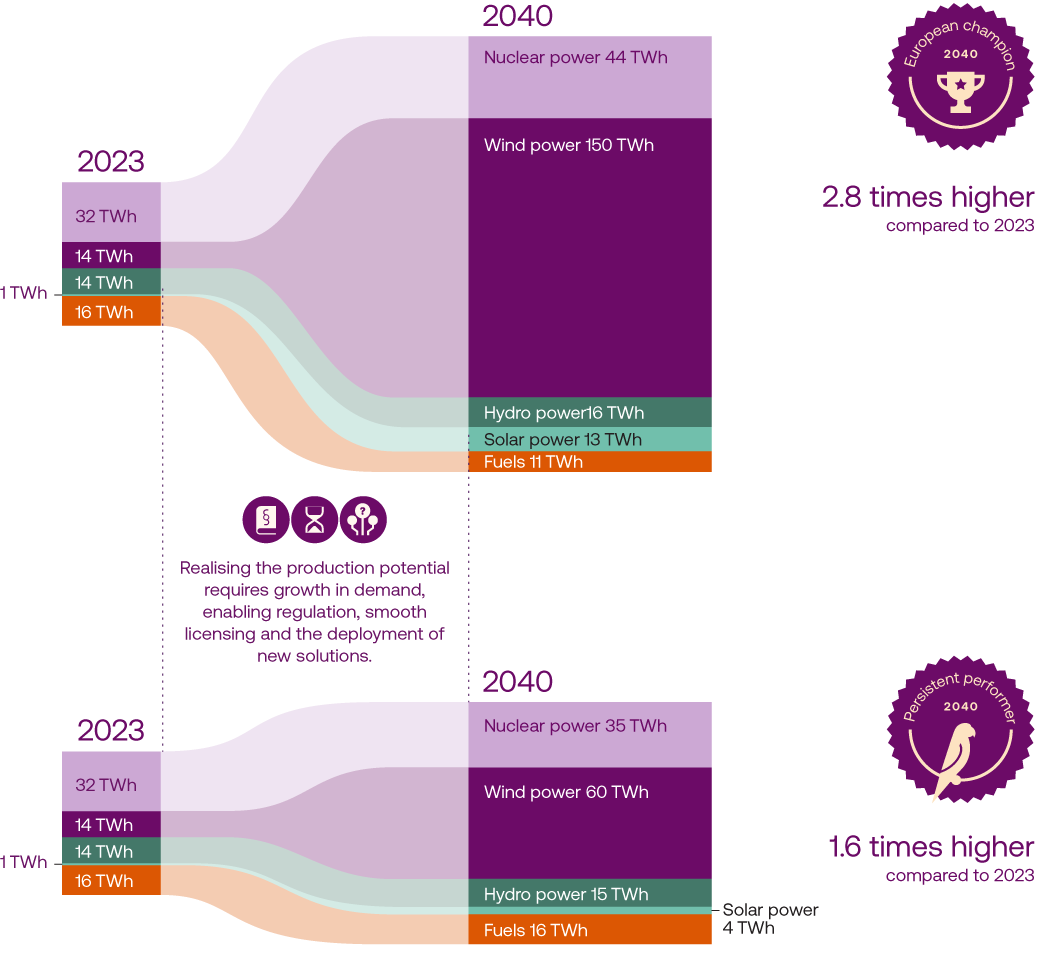
There is potential for growth in current technologies…
+ Very competitive in terms of price
+ Good investment prospects throughout the country, once the obstacles in Eastern Finland have been overcome
– Production varies considerably
+ Important for security of supply, especially in winter
+ New business opportunities from carbon capture
– Price outlook for sustainable biofuel and electricity
+ Important for security of supply and the balance of the electricity system
– Limited scope for adding new plants
+ Highly cost-effective heat generation when electricity is cheap
+ Brings balance to the electricity system
+ Volumes growing strongly
– Requires a lot of transmission capacity
+ Low operating costs, facilities and infrastructure exist
+ Well-known technology
– High construction costs, long permit processes
+ Energy from the incineration of non-recyclable waste is used in the production of electricity and heat; in the future, carbon dioxide capture will make it possible to replace fossil raw materials in the manufacture of products (CCU technologies).
…but new solutions are also needed
+ Technology is developing rapidly
+ Great investment potential
+ More consistent production than onshore wind power
– Technical challenges related to winter
– The cost level is high so far
+ Would balance the electricity system and smooth out price peaks
+ Competitively priced, rapidly evolving technology
+ Great investment potential
+ Volume growing
– Production is highest in summer and low in winter, the opposite for demand
+ Technological advancements are promising
+ Allows the use of new byproduct heat as the district heating system evolves
+ Technological developments are promising, especially in reactors designed for heat production, offering a potential production method in areas where byproduct heat is not available
- Currently high investment costs, but mass production could reduce prices
Wind powers the welfare state
In 2040, Finland has 7,500 wind turbines. They are strategically placed on land and at sea in locations beneficial for society, nature, and the energy system. Finland’s electrical grids are robust, and challenges related to the radar operations in Eastern Finland have been resolved. Thus, the local benefits of wind power are distributed across the entire sparsely populated country.
Due to its cost-effectiveness, wind power generates two-thirds of Finland’s electricity. Environmental and landscape impacts are managed through flexible placement and responsible project planning.
In the second scenario, there are only 3,500 wind turbines, and their placement is concentrated. Finland does not gain the desired new engine for its welfare state from wind power.
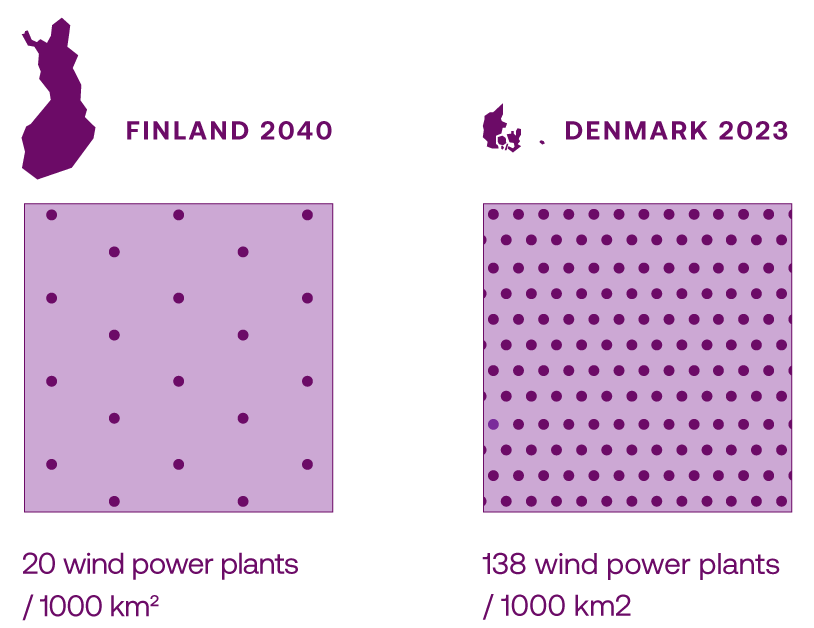
Thanks to a competitive operating environment, smooth permitting processes, and increased demand, Finland has built a significant amount of new electricity production. By far the largest production method is onshore wind power. Offshore wind power, solar power, and nuclear power have also increased substantially. The flexibility of power generation has improved due to upgrades in hydropower capacity, the establishment of a few new facilities, and pumped hydroelectric power.
Combined heat and power generation still utilises some wood fuels alongside waste fuels. Annual production investments have been in the billion-dollar range throughout the 2030s.
Finland is a leader in small-scale nuclear power. A few medium-sized modular nuclear power plants produce about 9 terawatt-hours of stable but adjustable electricity per year. In addition, several small nuclear boilers are the main source of un-burned heat in large cities, alongside industrial-scale heat pumps.
Production investments have been directed towards replacing fossil fuels in industry, transportation, and heating. Finland’s uncertain operating environment, slow permitting processes, and industrial investments in other countries have resulted in the country losing electricity production investments to competitors. Small-scale nuclear power has not been implemented in Finland. Increased rainfall due to climate change has slightly boosted hydropower production without new investments.
Industry still maintains a significant amount of combined heat and power generation, primarily using wood fuels. Waste fuels are utilised in combined heat and power generation for electricity and district heating.
Small-scale nuclear power has not reached techno-economic viability in Finland. Legislation, which only partially allows modularity and series production, increases costs. Zoning has not found viable sites for nuclear thermal plants.
Networks enable the transition
The new energy system is based on robust grids. Finland’s success in grid construction is based on expertise and an excellent starting point, along with smart incentives.
With a much stronger electricity distribution network, new production and consumption can be aligned. Hydrogen covers as much as half of Finland’s north-south energy transmission.
Heat networks enable the utilisation of heat generated by industry and data centres in cities. Heat storage allows the storing of heat produced in summer for use during winter.
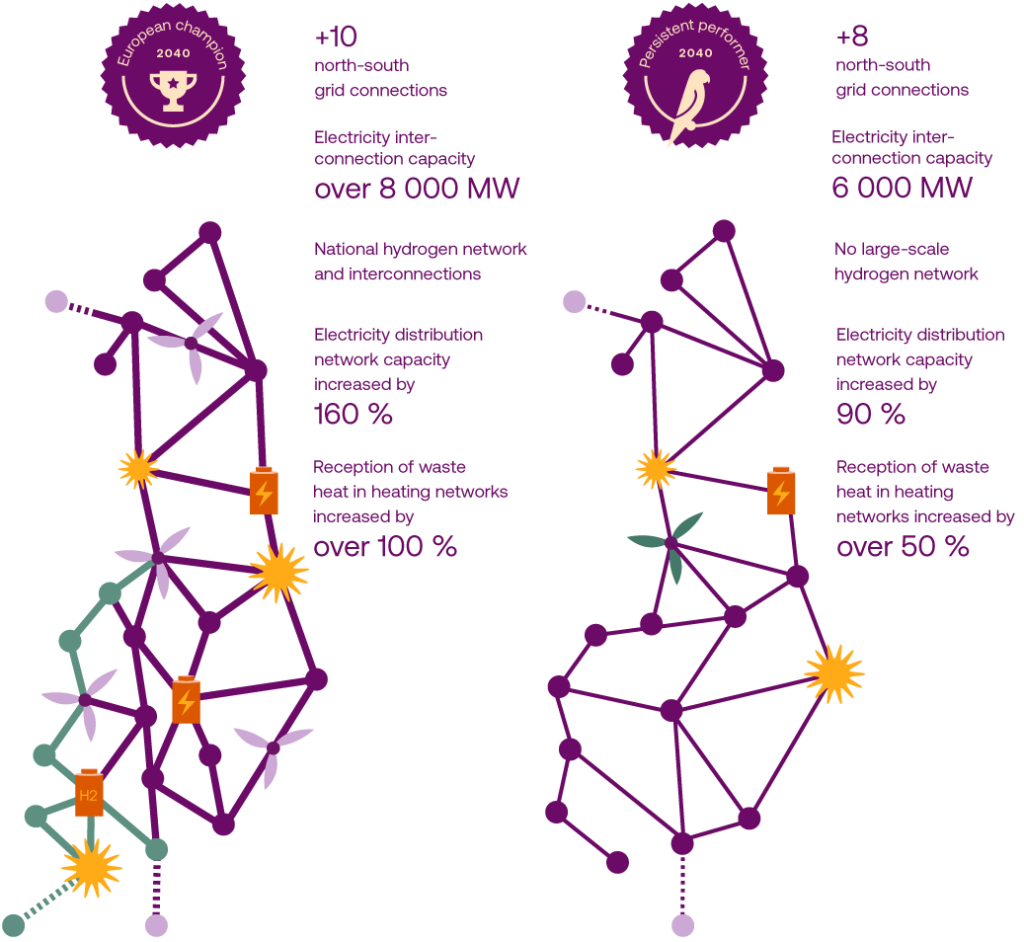
The electricity and hydrogen transmission networks have been built in synchronisation, ensuring that users – both industrial and consumers – receive energy reliably to meet their growing needs. The placement of networks and production facilities is planned in collaboration with energy-intensive industries. Hydrogen and heat networks, along with large energy storage facilities, smooth out fluctuations in production and consumption.
Customers, served by a strong electricity distribution network, are active participants in the energy system. They have incentives to increase or decrease consumption as needed. Thanks to artificial intelligence and robust networks, flexibility occurs automatically, ensuring good reliability and reasonable costs.
Energy is also exported to neighbouring countries as electricity, hydrogen, and refined fuel products, but above all as value-added industrial and service products.
District heating significantly balances the electricity system: a total of three gigawatts of capacity from electric boilers and hundreds of gigawatt-hours of heat storage help manage supply and demand. District heating networks enable the utilisation of waste heat generated by industry and services, thereby improving viability of investments.
The utilisation rate of the grids is high. Occasionally, the energy networks are unable to direct or store all renewable energy for beneficial use, thereby necessitating production limitations. Industries and services have limited opportunities to invest in Finland due to insufficient transmission and distribution connections.
The sufficiency of electricity is occasionally dependent on imports. During electricity surplus situations, heat networks act as storage.
Hydrogen networks are local and serve industrial production processes. Synthetic fuels are produced to cover part of the domestic consumption in heavy transport. Properties regulate their own energy consumption based on price signals.
The development of electric boilers and heat storage in district heating has slowed down due to taxation, zoning, and network constraints. Industrial-scale heat pumps mainly utilise environmental heat, as byproduct heat from new industry is scarce due to new investments being sidelined.
The balance of the electricity system is built on versatile flexibilities
Competitively priced, variable energy production has increased tenfold in Finland. The balance of the energy system is ensured through all available means.
Hydropower and nuclear power, along with fuel-based capacity, balance the fluctuations of onshore and offshore wind power and solar power. The electricity consumption of industries, households, and transportation adjusts with active and automatic control. Heat networks store large amounts of energy.
Hydrogen production flexes with the help of hydrogen networks and storages. In Champion Finland, electricity transmission connections to neighbouring countries are needed more than twice the amount in 2023. The predictability of weather-dependent production and curtailment facilitate balancing when necessary.
Nature sets the boundaries for energy transition
Detaching from fossil fuels and their production chains is the greatest environmental action in the energy sector. Effectively combating climate change also helps prevent biodiversity loss.
Conserving nature values remains crucial, whether aiming to become the European champion or settling for the less ambitious scenario. The scale of the challenge and the approaches vary in part. In Finland with strong economic growth, the energy system is larger, but so are also our means to mitigate and compensate for environmental impacts.
Land use plays a pivotal role in determining environmental impacts. Larger wind turbines now require less total land area in nature, allowing avoidance of areas with the highest conservation value. The modest land footprint of increased nuclear power has reduced the land use impact of energy.
Diverse nature can thrive alongside energy networks and production by harmonising operations with local conditions and valuing environmental considerations.
Areas needed for energy production and distribution
- 1.7 % of Finland’s land area is less than 500 metres from a wind turbine – equivalent to the size of Kuusamo.
- 0.4 % is under power lines or on top of underground cables – equivalent to the size of Hyrynsalmi.
- 0.3 % of wood energy equivalent to Finland’s forest area is extracted from industrial side streams for district heating and electricity – equivalent to the size of Hartola.
- 0.05 % of Finland’s land area is used for solar power production – equivalent to the size of Kustavi.
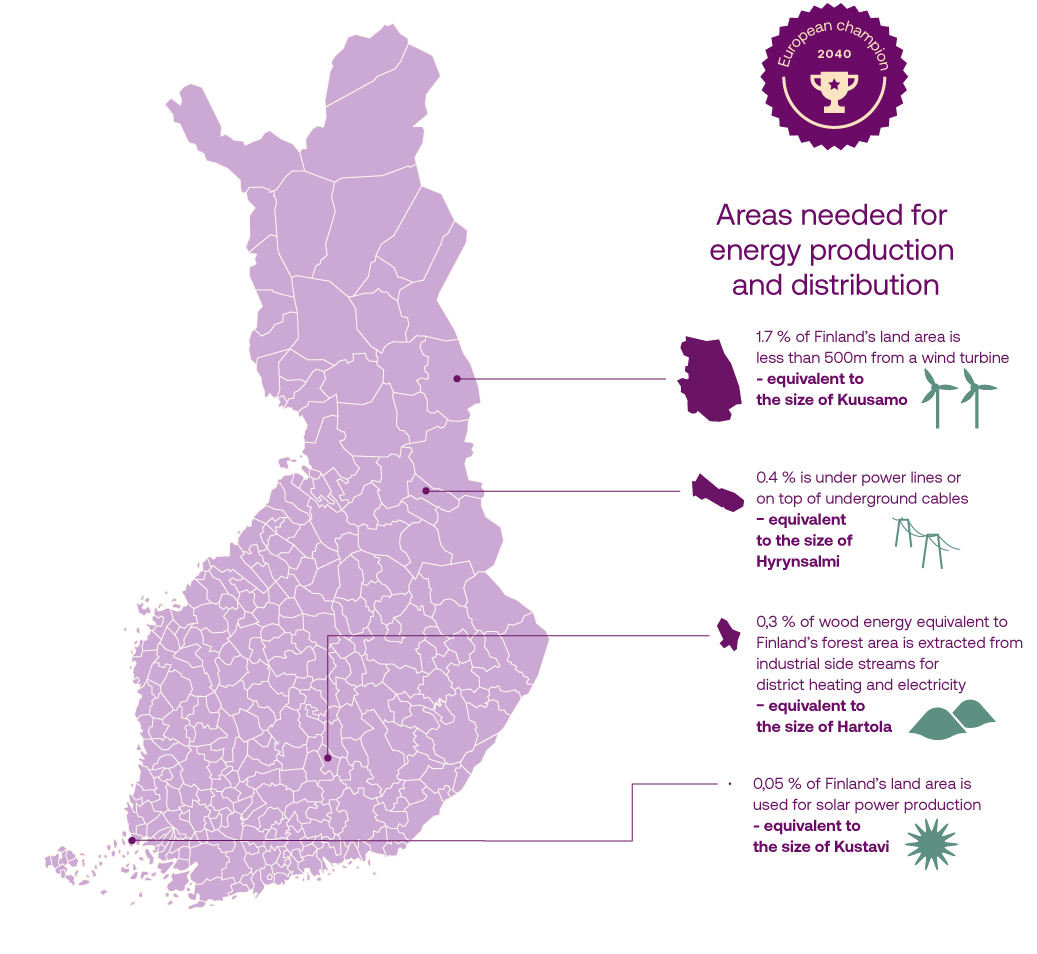
Finland is a self-sufficient participant in the European energy market, safeguarded by its diverse energy system. A competitive cost level is provided by wind power as the main source of electricity added with means to balance out its fluctuation. Economically strong Finland ensures security and maintains social cohesion.
Considerable efforts have been made to account for the environmental impacts of energy in planning and permitting. After minimizing the impacts, the remaining effects have been compensated. Migratory fish populations can thrive in most hydro-power water bodies thanks to various bypass solutions. Dams that have lost their purpose have been dismantled.
Electric grids have been constructed strategically to minimize land use needs and avoid habitat fragmentation. Diverse meadows, traditional biotopes, and wetlands flourish in the power line areas.
Due to the responsibility and benefits of energy production methods and networks, they have strong public support. This has been reflected in consistent regulation.
Forest biofuels for district heating and electricity production are sourced from industrial by-products, and their use has decreased. The industry follows forest management practices that consider biodiversity to protect valuable areas. Drainage has been reduced, the amount of deadwood has increased, the age structure of forests is more diverse, and the impact of logging operations is less significant than before.
In collaboration with the Nordic and Baltic countries, Finland is largely energy self-sufficient, and energy security has been ensured. Finland has not succeeded in competing for new electricity production and consumption investments, and customers are somewhat unequal in the energy market.
Environmental impacts of energy have been mitigated through voluntary and mandatory measures, partially limiting investments. The minimum European targets for environmental conditions have been met. Companies have good examples of local sustainability projects. There is a lively debate about the acceptability of energy production and networks.
Customer benefits from a virtuous circle
The energy transition is not free, but failing to make it would be immeasurably costly. Successful Finland has attracted entirely new energy users, who are bearing their share of the costs of generation and grid investments. A strong economy enables the welfare state to provide services for the less privileged.
The industries actively participate in balancing supply and demand. Customers can take advantage of price fluctuations through different types of contracts, their own energy production, storage, and automated consumption control. Additionally, households and businesses can choose suitable ways to protect themselves from price fluctuation risks. Energy companies act as partners for customers in these efforts.
In the persistent performer’s Finland, new investments in energy-intensive industries have not been attracted, resulting in less need for electricity production, flexibility, and storage.
Summary: a bright energy future ahead
The energy sector calls on everyone to make Finland the European champion in energy transition. The task is not Mission: Impossible. The opportunities are much greater than the obstacles on the path to a bright future vision.
Finland must aim for more than just meeting its climate obligations in the energy transition. Clean energy can become a strong growth factor. Growth comes from investing even more significantly than in past years. The growth of clean energy-related industries and business activities has significant employment effects, especially in export industries, and helps finance the welfare state expenditures. While most of the significant growth in electricity production comes from wind power, other forms of production are also needed.
Electrification, the hydrogen economy, and the flexibility brought by district heating networks form a competitive and reliable whole. Building electricity transmission and distribution grids, as well as hydrogen networks, is essential for growth, as they help balance new production and consumption. It is crucial to implement all factors that balance weather-dependent production and adapt to new operational methods.
With strong growth, there is also greater responsibility and capability to find new ways to care for biodiversity. A new, more environmentally friendly energy system can fit well in Finland. It is important that the prosperity it brings is distributed throughout the country.
Energy markets guide the development of the energy system to meet customer needs. Customers, with their new alternatives and services, are in a good position in the future energy world.
A bright energy future is achievable.
Steps for decision-making
Finland constantly faces challenges in its economy, security, and environment, and the world of competition isn’t always fair. We need to excel in creating a favourable investment environment and leveraging our strengths. We do not succeed in a competition of state aid schemes.
We have many strengths, such as favourable wind conditions, vast land area, high expertise, reliable networks, digitalization, stable ground, and a cool climate. We cannot succeed in the energy transition alone, so we invite all parties to join forces and capitalise on our strengths.
Let’s create the policy conditions for achieving excellence.
Finland – the best location for energy-intensive industry
How can energy investments be made to generate sustainable growth and jobs in Finland?
Challenge: Large quantities of substantial long-term investments are needed, but their profitability depends on the future direction of climate and energy policies and the choice of regulatory measures. Competitors attract investments with substantial state aid as well. Uncertainty slows down the energy transition and complicates investment financing.
Solution:
Strengthening the market demand for climate solutions by setting targets and main guidelines for climate governance for the period 2030–2050 in the EU and nationally.
- Continue to expand and strengthen emissions trading, thereby avoiding regulatory measures such as national taxes or subsidies that increase investment uncertainty.
- Develop energy taxation towards a fossil-free energy era in a long-term manner. The energy transition should not be slowed down by taxing fossil-free energy.
- Adhere to the long-term course of energy policy and assess the impacts of changes over the long term.
- Accelerate investments by setting a total timeframe for permits and developing a comprehensive cross-administrative electronic service system.
Diverse production ensures global competitiveness
How does Finland ensure competitiveness and energy security?
Challenge: The energy system must be rapidly transformed to meet climate targets and remain competitive in a tough global market. Throughout this transformation, the system needs to remain reliable and affordable.
Solution:
Ensuring that Finland maintains a diverse energy portfolio by safeguarding the operating conditions for all production methods that provide us with competitive advantages and energy security. Guide the selection of production methods by limiting their negative impacts, such as emissions and environmental effects.
- Treat nuclear power on par with renewable energy and enable the construction of small modular reactors in urban areas.
- Recognise the importance of hydropower under the Water Framework Directive and maintain the Water Act as the governing legislation for water use.
- Secure the utilisation of forestry and industrial by-products for electricity and heat production.
- Accelerate the construction of onshore and offshore wind power across Finland by streamlining zoning procedures and addressing constraints related to radar systems.
- Create value for captured carbon dioxide in the European market. Accept carbon dioxide derived from sustainable bioenergy and waste as raw materials for the production of synthetic fuels.
Integrated energy networks enable the energy transition and growth in well-being
How Finland achieves its carbon neutrality goals and growth cost-effectively?
Challenge: The energy system is diversifying, requiring integration of new production, consumption, flexibility, and storage solutions. Significant opportunities arise from the growth in variable electricity production, hydrogen production, and waste heat utilisation, all of which require substantial energy transmission.
Solution:
Provide an enabling environment for the energy grids, that promotes sustainability, innovation, and market flexibility. Strengthen and proactively build new electricity, gas and heat networks through a long-term regulatory framework to anticipate customer needs and take into account the decades ahead.
- Streamline procedures for grid siting and permitting.
- Ensure efficient and equitable construction of energy grids from the perspective of customers and operators.
- Develop a national strategy for clean gases (biogas, synthetic methane, and hydrogen) to strengthen gas grids as part of the future energy market and sector integration.
- Provide energy grids with the capabilities to serve as platforms for various energy forms, technologies, services, and sector integration.
Customer benefits are secured with fair market regulations
How do consumers and business customers benefit from a new energy system?
Challenge: Customer needs and opportunities vary. Customers should be able to participate in energy markets and protect themselves from risks. Responsible development of the energy system requires consideration of social and economic impacts. Bringing customer-generated flexibility to the market benefits everyone.
Solution: Legislation is created to facilitate the supply of advanced energy products and services. Energy market rules are further developed towards openness, efficiency, flexibility, fairness, and clarity. Differences in electricity, heat, and gas markets are acknowledged.
- Ensure the cost-effective integration of flexibility across energy system components (electricity, heat, gas).
- Create a level playing field for district heating and on-site heating solutions. Use company-specific district heating emission scenarios in calculating emission factors for buildings. Streamline the use of waste heat through planning and permitting.
- Enable the offering of various pricing models to customers without unnecessarily increasing regulatory risks.
- Remove barriers to electrification and the adoption of other clean energy technologies, and support research and development of new energy technologies.
The energy sector needs its changemakers
How can the job opportunities of the energy transition and the supply of skilled labour be matched?
Challenge: The energy transition requires top experts and continuous renewal of skills. Both experienced professionals and new talent are needed to develop and create new solutions. Energy companies employ significant number of people, but the value chains in the sector can employ three times as many. Securing future top talent is essential for companies to succeed and enable this extensive employment.
Solution:
Ensure financial investments in skills development. Seize job market potential of new tasks in solving the climate crisis. Ensure the renewal of skills at all levels of education.
- Improve proficiency in natural sciences and mathematics starting from primary school. This is the foundation for future top expertise.
- Create and enable multidisciplinary skills and interdisciplinary approaches at all levels and fields of education.
- Secure that there are enough education and training positions available, and that they are regionally comprehensive, to have enough skilled technicians, product developers, digital experts, or nuclear physicists to meet the needs of the energy transition.
The energy system vision 2040 was created through the collaboration of Finnish Energy (Energiateollisuus ry), its members, and stakeholders. The concept and communication consultancy was provided by the sustainable development agency Kaskas.
Finnish Energy gathered a current perspective on the development needs, direction, and challenges of the energy system. This utilised a wide range of domestic and European studies.
The perspective was divided into two scenarios, which were questioned, supplemented, and modified in stakeholder workshops held in November 2023. The first workshop focused on the overall picture, functionality, and development requirements of the energy system. The second workshop focused on defining the key sustainability challenges related to energyʼs climate, nature, security, and price issues, and finding solutions to these challenges.
- EHB: European Hydrogen Backbone (2022)
- Confederation of Finnish Industries: Investment map of the Green Transition
- Finnish Energy: Low-carbon roadmap (2020,2021)
- Finnish Energy: Sustainable energy future for customers (2018)
- Finnish Energy: Kaukolämpöalan strategia (2023)
- Finnish Energy: Työmarkkinaskenaario (2021)
- Finnish Energy: Biodiversity roadmap (2022)
- Finnish Energy: Energiaverkot 2035 (2022)
- Finnish Energy: Jakeluverkkoyhtiön tulevaisuuden rooli (2021)
- ENTSO-e, ENTSO-g: Ten-year network development plans (2022)
- Eurelectric: Decarbonisation speedways (2023)
- Eurelectric: Power plant (2022)
- Eurelectric: Power2People (2020)
- Eurelectric: Connecting the dots (2021)
- Fingrid: Electricity system vision (2023)
- Gasgrid: projects on hydrogen economy (2023)
- H2 Cluster Finland: Clean hydrogen economy strategy for Finland (2023)
- IEA: World Energy Outlook 2023 (2023)
- Quantified Carbon & Fortum: Nordic power systems (2023)
- SITRA: The role of electrification in achieving Finlandʼs climate targets (2019)
- The Finnish Climate Change Panel: Teknologisten hiilinielujen mahdollisuudet ja niiden edistäminen Suomessa (2023)
- Ministry of Economic Affairs and Employment: National climate and energy strategy (2022)
- Ministry of Economic Affairs and Employment: Hydrogen Europe Hydrogen Insights (2023)
- VNTEAS Hydrogen economy: Opportunities and limitations (2022)